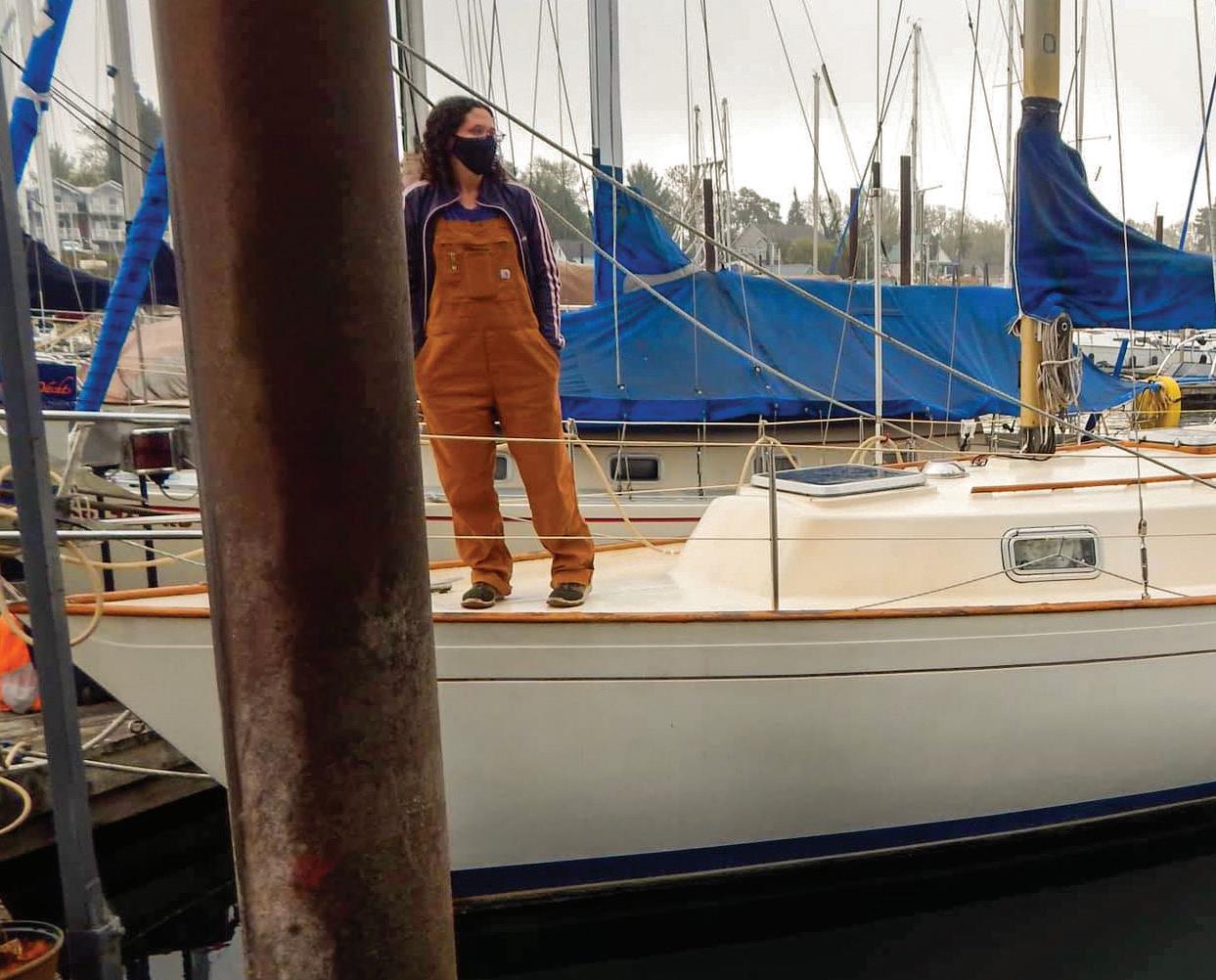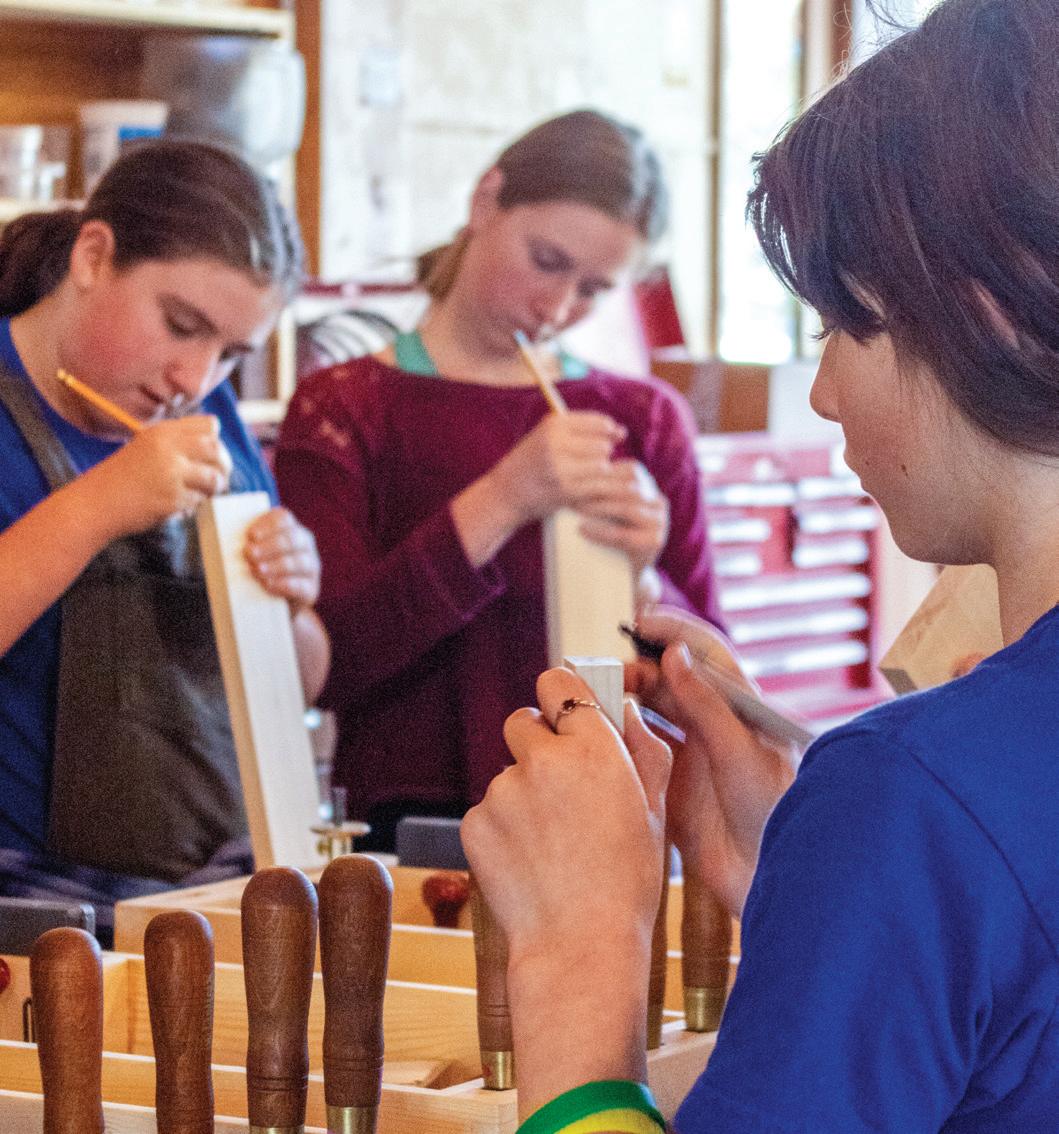
11 minute read
Who Rescued Whom?
by Rob Hodge
WHO RESCUED WHOM?
Why does one take on a boat project? Why make a difference in an at-risk boat’s life? I've asked myself that many times. And yet, the answer eludes me.
For all the time and effort I've put into my Lightning dinghy, Lady Jane, I could have bought a much newer, more modern boat that was ready to go. I could have been on the water, enjoying this other hypothetical boat instead of spending my spare moments scraping, painting, and working to bring a wooden hulk back from the dead.
So how did this happen? How does one decide to adopt an at-risk boat?
The Lady Jane came to me through a Facebook group. The previous owner had purchased her 20 years prior; she had been intended as a bonding project for his newly minted son-in-law. Once a grandkid came along, these plans fell by the wayside and she was relegated to sitting in a barn. He was getting older and looking to clear out the barn, but also wanted to see her back on the water. He'd tried to rehome her, but every wooden boat organization, non-profit, and boat building school in the area had passed on her. As a last resort, a volunteer at one of these organizations floated a post on Facebook. I was the only one to reach out. make sure I'd be able to haul it away when I showed up. It was a wreck. the bottom had been roughly sanded to bare wood with an angle grinder. The mast was in pieces, destroyed by dry rot. All the cockpit trim, rub rail, benches, and other random pieces were in a pile in the cockpit. A later inspection would reveal a split bottom plank, a mast step in need of replacement, five broken half ribs spanning from the centerboard trunk to the chine, two broken full length ribs, and a myriad of other issues in need of repair. I had thought I'd be sailing the boat in a year. It took two-and-a-half years until it saw the water. In three, it was finally comfortably set up.
The Lady Jane is a Lightning class one design; she carries sail number 6724 as issued by the class association in 1959. Designed by Sparkman & Stephens in 1938, the Lightning class is a 19-foot, three person dinghy. Originally drawn for wood construction, the class has transitioned to fiberglass hulls and aluminum spars. With more than 15,000 built, the class is active and still supports those who own boats from the wooden era. From class records and what I have been able to research locally, it is my belief the boat was originally built in 1959 and 1960 by a pair of individuals in a garage on Beacon Hill in Seattle. She was raced into the early 1970s on Lake Washington. Early records
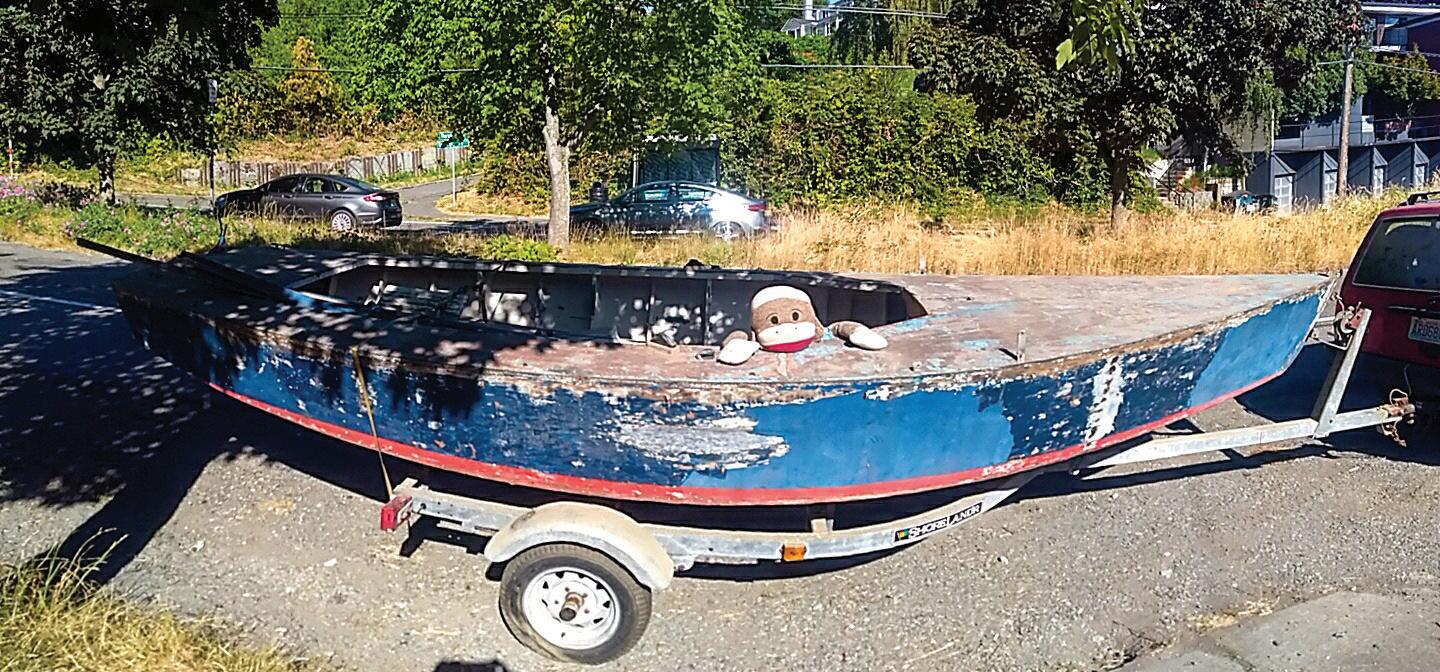
This is what the Lightning looked like when the author picked it up. His sock monkey crew looks worried.
I was fresh off of a failure in the first leg of the 2017 Race to Alaska (R2AK) that had opened my mind to looking for a dinghy with better sailing characteristics than the plywood brick my other boat had been. My wife was receptive to the idea, especially since a refit project would keep me busy with a boat on the hard, rather than being out on the water (or in it, as had been the case for a short portion of my 2017 R2AK attempt).
After a string of emails back and forth, my bid to take ownership was accepted. It is often said that the most expensive boat is a free boat; this went beyond free. Upon realizing that one tire was flat, the owner ran out to buy new tires for the trailer to list her by just her sail number, though she was briefly named Fascination. I have no record giving her the name Lady Jane, however that is what was on the side of the boat with mailbox stickers when I got her. While I can find no record of her ever winning a race, I have found a picture in a Corinthian Yacht Club of Seattle scrapbook of her racing on Lake Washington in 1965. When I began work, I wasn't exactly sure what to do with her. Old wooden Lightnings aren't typically competitive amongst more recent builds; and even if they were, the local Lightning fleet went defunct over 40 years ago, leaving the nearest active fleets to be in Canada or Portland. My sailing trends towards
cruising anyway, and I loved to dinghy cruise with my old boat — sleeping at anchor in the tiny cabin on my 12-footer. Tent camping on a boat is a poor substitute for a cozy cabin, so it seemed that this boat, as designed, might be a phenomenal day sailer but would not be suited for longer trips. Work progressed slowly.
Inspiration came in the form of three grainy pictures, cellphone snapshots of pages from an old book. The photos were taken and sent to me by Lee Bjorklund, a member of the board of the Center for Wooden Boats in Seattle. These three pictures showed conversions done to Lightnings, adding a cabin to enclose the front half of the cockpit and underneath the foredeck. Further research turned up references to the “Gypsy” design — a variation on the Lightning design offered by a famous builder of wooden Lightnings. The Gypsy included a cabin, though not even the experts at the Lightning class could say much about this variation with much certainty. newer fiberglass Lightning located out in Ocean Shores.
Design of the cockpit was done by eye, and by feel. I clamped boards to the boat in specific places to mock it up, and then inspected the resulting shape from all angles. Early on, a straight up-and-down side to the cabin was ruled out, and the sides became angled in — this looked more appropriate and true to the design. I did sit-down and lay-down tests in between each adjustment, getting inside my cabin mock-up and testing to see how comfortable the result would be. Over the course of a few days, the design started to come together. I'm quite happy with the aesthetics of the result, and feel it has just enough curve and just enough straightness to fit in with the hard-chine design of the original boat.
Far deviated from one-design rules at this point, other considerations led to further modifications. The Lightning is originally set up as a boat for windward/leeward buoy races, with a fractional jib and a symmetric spinnaker with a pole. In an effort to modernize, simplify handling, and improve reaching performance, I added a bowsprit to be used with an A1.5 asymmetric spinnaker and reaching Code Zero on a roller furler. While I keep the pole on board and rigged to hoist the symmetric, it is also rigged to fly the asymmetric spinnaker for downwind runs. All halyards are led aft to the cabin top to Spinlock PXR clutches, and the ball bearing jib cars are adjustable from the windward rail, as is the double-ended vang. Spinnaker and jib sheets are endless, and all halyards and sheets are high-tech and tapered to save weight. Though 60 years old, the boat has more in common with modern sport boats than with other wooden Lightnings.
More adjustments were required to accommodate these further modifications. The companionway needed a particularly clever solution, as a typical sliding companionway hatch would interfere with the boom vang. The solution was to create a fourpiece telescoping companionway hatch. Each board slides in its own groove, and has a small cleat on the bottom of the aft edge and the top of the forward edge. When closed, these collapse into a 6-inch long doghouse at the front of the hatch. When closed, each board slides forward, pulling the one above it to

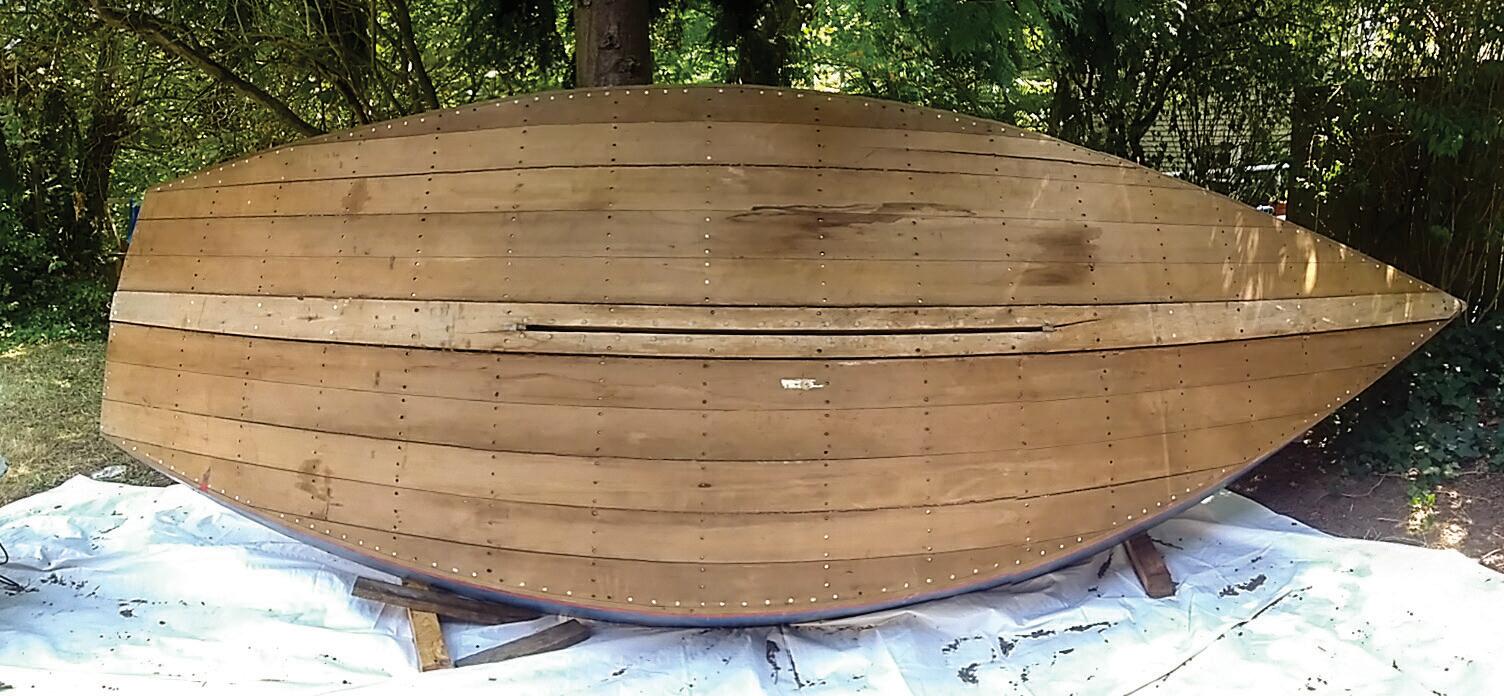
Hull work and plank replacement in process. More than 500 new fasteners were required.
Influenced by these ideas, I hatched a conversion plan. Watertight compartments were added fore and aft after studying the capsize and stability study of wooden Lightnings on the class association's website. The boat was divided up — flotation in the bow, seven feet of lay-down space in a cabin, five feet of cockpit, and four feet of flotation in the stern. I altered the mast step, adding a few inches in mast height to make more room for the cabin top. I cut the original mahogany benches down to fit the smaller cockpit.
These modifications complemented the less visible repairs. I refastened the entire bottom, replacing about 500 deteriorated brass screws with bronze screws one size larger and ¼-inch longer. The spilt plank was replaced. I found a replacement mast and rudder on Craigslist in Wenatchee, of all places; as well as a modern-profiled stainless steel centerboard from a
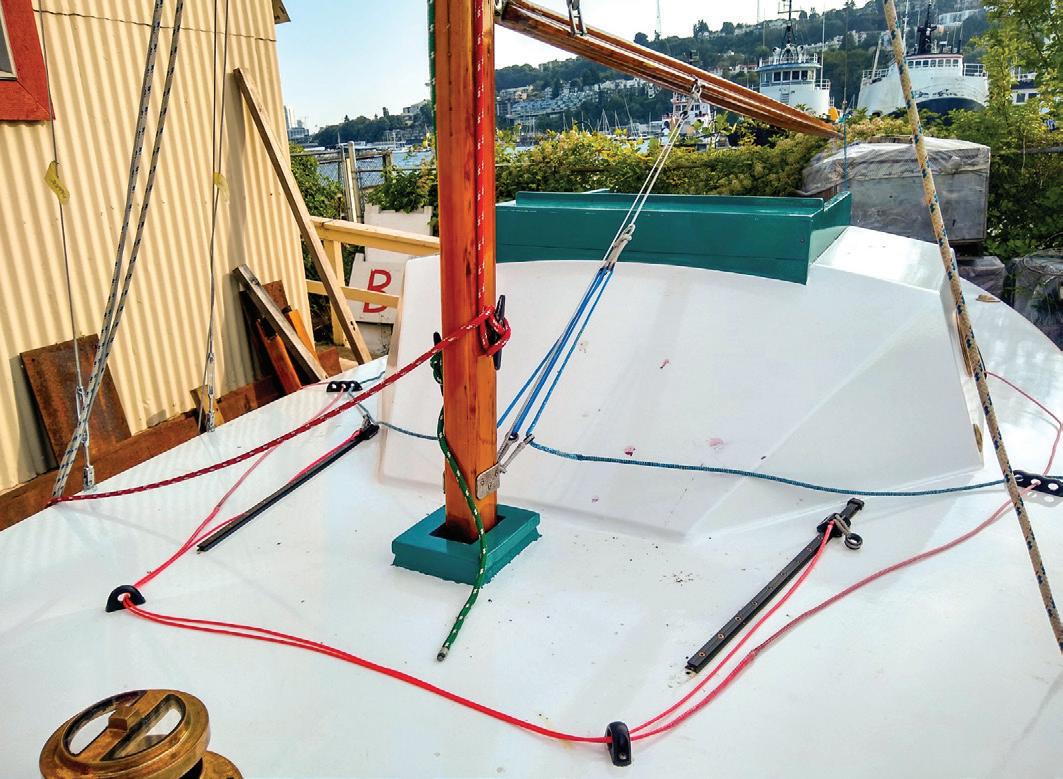
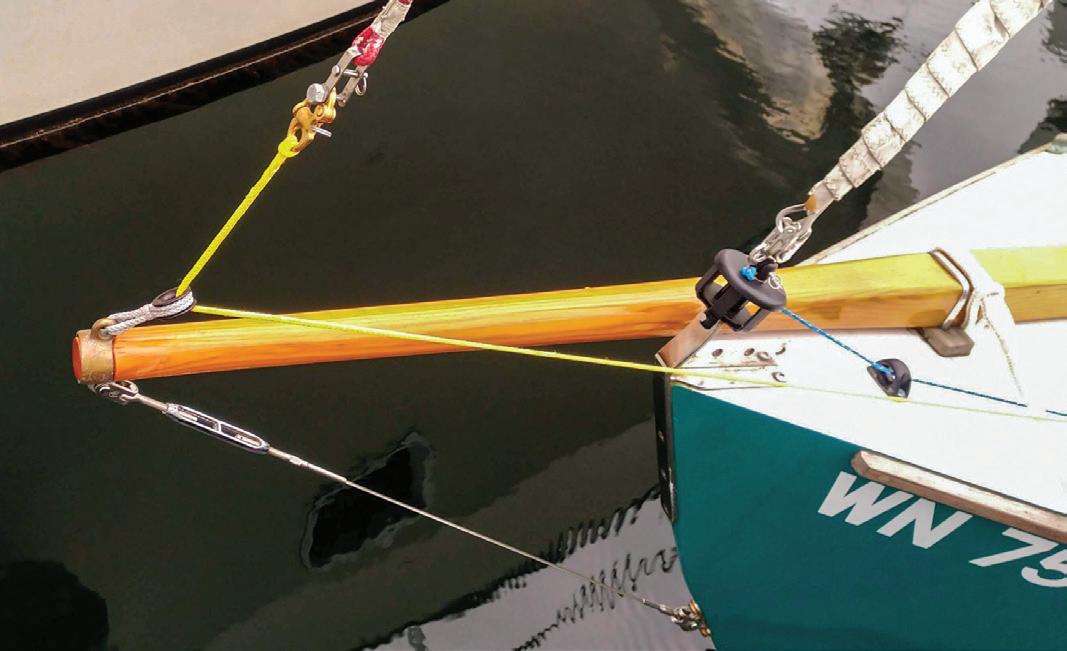
The addition of a bowsprit enables use of an asymmetric spinnaker and a Code Zero.
create a stepped hatch 24-inches from front to back. While it is relatively water tight, the hatch design also includes an internal gutter to collect any rain that gets through, routing it out of the cockpit to keep it dry inside.
Jib sheet routing also required some creativity — with the cabin making direct sheeting common on most Lightnings out of the question. The solution ended up being to run the sheet through an anodized fairlead at the front of the cabin, back to a foot block for a 90 degree turn into a PXR clutch. The sheet is endless; each end attaches to the sail and forms a loop through the cockpit and deck hardware. Because of this, the lazy sheet can be used to retrieve the active sheet without moving from the rail, and adjustments can be done easily.
On a Friday at the end of August 2020, I hit a huge milestone. After at least 20 (and maybe as many as 40) years ashore in various venues, I hauled the Lady Jane to a boat ramp on Lake Union and the boat felt the water once again. There were definitely a few leaks, but I said at the time, “It’s sinking, but at an acceptable rate.” Being a wooden boat, those leaks diminished in the coming days. I sailed it proudly in the light air, impressed by the easy way the boat moved. Friends from the Center for Wooden Boats joined me on the water to celebrate and take photos.
My design changes have worked well. The deck and running rigging layout is a tad unconventional in places, however the result is that much of the sail trimming can be done on the fly without moving from the upwind rail and affecting the weight distribution. The boat sails beautifully, and is remarkably well behaved. When the tiller is locked down with the tiller comb, the boat will sail upwind without any input clear from Shilshole to Point Jefferson. The cabin is surprisingly comfortable, and I have spent several nights aboard and even done some overnight trips with my son.
There are further modifications planned. Currently, I am adding an electrical system with a 60Ah lithium battery at its core. This will power navigation lights and a basic electronics package, as well as a crash pump. I plan to do some experiments with a trapeze setup once the donated set of hardware materializes. My eventual goal for this boat is to attempt the R2AK again; though exactly how far out that is is uncertain at this point.
The boat is moored at Shillshole now. Every day when I leave or return to my liveaboard, I see it. It's ready to sail whenever I want, and I take her out as often as my hectic life allows. Three years of work and uncounted dollars later, and I still ask, “Why?”
I know every detail of the boat — where every broken screw lies, every bad cut hidden with epoxy, every place the wood soaked in a drop of blood. Some see it as a thing of beauty, unburdened by that knowledge. But, I remember my son handing me screws as I lay on my back installing replacement ribs. I remember the afternoon friends and strangers from online wooden boat groups came over to help me pull her off the trailer and lean her against the tree to work on the bottom. I remember the many days of polishing the original bronze fittings to a mirror shine, and being impressed and relieved when they looked like I hadn't touched them a month after I put them on the boat.
It has been a long voyage before we ever left a dock, and I've arrived at this conclusion. Many memories, many stories. A kinship with an inanimate object. I still can't tell you why someone would decide to take on a project boat. I can't tell you why one decides to make a difference in an at-risk boat's life. But I can definitely tell you you'll be glad you did.
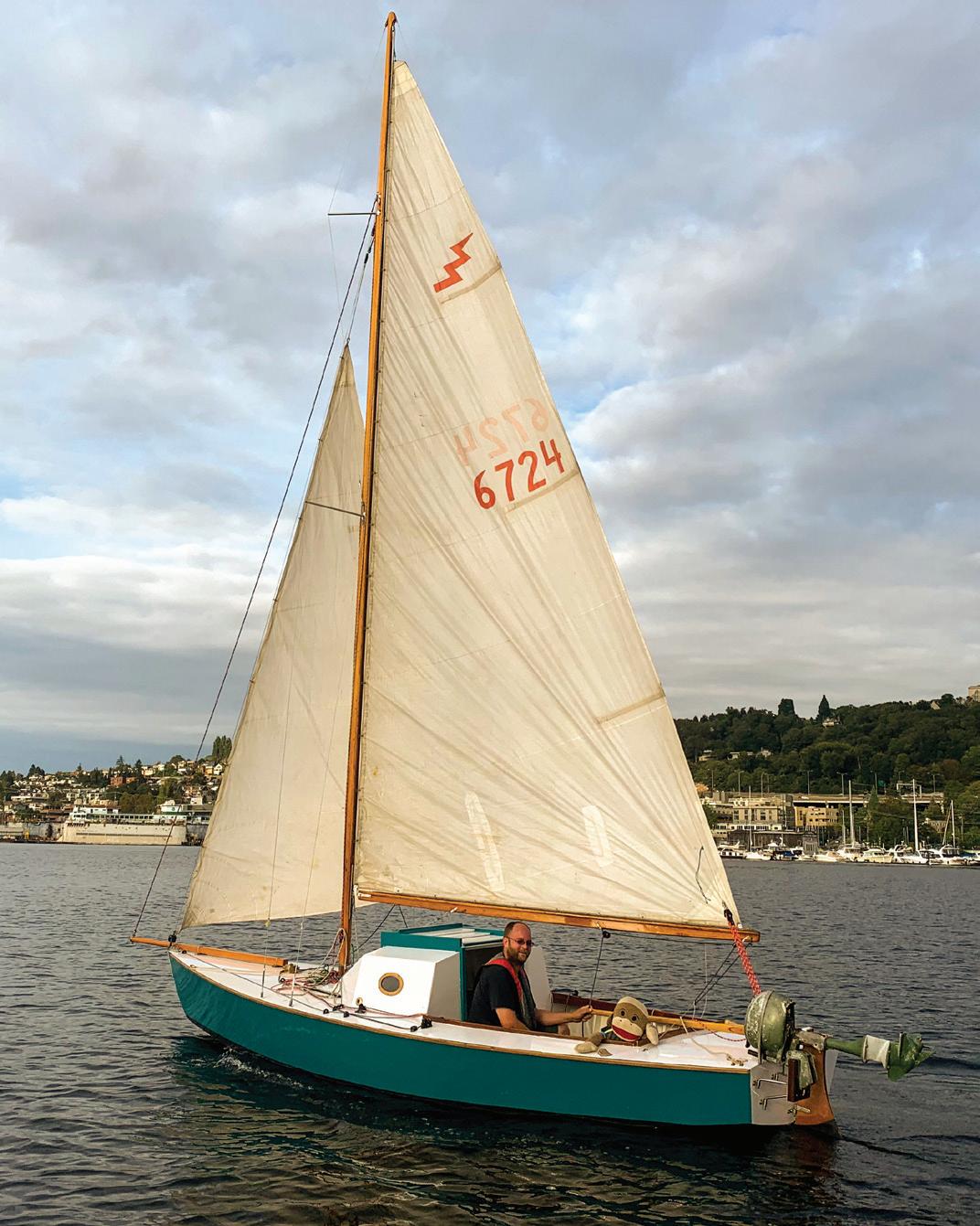
Rob enjoying his maiden voyage on the refit Lightning in August 2020.
Rob Hodge lives aboard and sails the Lady Jane out of Shilshole Bay Marina. Further details about the rebuild and his adventures are available at www.h2ak.com.



